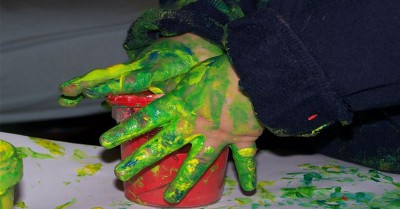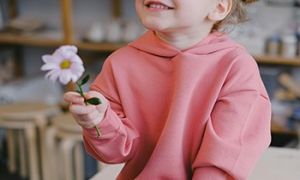Few things can hold a baby in rapt attention or wring out a squeal of pleasure from a toddler as a palette of colours, paints and brushes. Art with its many sensory experiences has been found to aid brain development by increasing the number of neural pathways, especially in early childhood. So if you are planning to introduce art to babies and toddlers, here are few ways you can go about it.
Here are some simple strategies to engage babies and toddlers in art experiences:
Approach It Like Play
Make art time a playful experience in which the young ones get to use colour and materials as they want. This might mean splashing, squelching, dribbling, stamping with paint, dough or even mud. It is important for Educators to give enough physical and emotional space for babies and toddlers to engage in all such actions without worrying about ‘making a mess’. If parents are worried about paint-splattered clothes, ask if they can send oversized T-shirts or smocks for their kids to play in. Above all use lots of encouraging words, sounds and facial expressions so that the child feels noticed and supported in his or her journey to self-expression.
Use A Variety Of Materials
There is no reason why art should be limited to paper, paint and crayons. Instead keep a variety of materials and textures within easy reach for the young ones to pick and play with. These can range from beads, yarn, clay, string, fabric, sponge and glue to wood, leaves, shells and even veggies. While you can ensure that the materials are age-appropriate and non-toxic, resist the temptation to give directions on what tools to use and how to use them to obtain a specific result. So if you find a toddler not succeeding in getting paint to stick on a box, rather than pushing forward the bottle of glue, you might instead encourage them by saying, "I wonder what would happen if you mixed a bit of this glue to the colours?" And let them discover what happens.
Focus On Process
Let the little ones draw and paint and build as they please. Avoid putting up any specific object as a model or nudging them into ‘copying’ something from the real world. Focus on art as an open-ended process for which there is no right or wrong way. What is most important is that babies and toddlers use art to express themselves; that they use the experience to explore their interests and attractions as much as their annoyances and frustrations.
Be Engaged
While your young learners may be completely immersed in their artistic endeavours, do keep in mind that they will look up to you for support. So show that you are deeply interested in what they are making and especially when they bring a finished artwork to you. These are also valuable opportunities for observing the young ones in your care – as they go about the process of creating art, you get the chance to evaluate their problem-solving skills, ability for self-regulation and how they interact with peers.
Art is a sensory experience for babies and toddlers, it's about the process of exploration - celebrate their artistic journeys for not just their ability to create but also their willingness to try out something new.



 As an Educator in Australia, your pay rate falls under the Children’s Services Award 2010. This award states the minimum amount that an employer can
As an Educator in Australia, your pay rate falls under the Children’s Services Award 2010. This award states the minimum amount that an employer can When working as a qualified Early Childhood Teacher (with a university degree) within a service, your rate of pay will come from the Educational Services
When working as a qualified Early Childhood Teacher (with a university degree) within a service, your rate of pay will come from the Educational Services When working as a Diploma Qualified Educator your pay rate is from the Children's Services Award 2010. This Award states your minimum rate of pay
When working as a Diploma Qualified Educator your pay rate is from the Children's Services Award 2010. This Award states your minimum rate of pay When working as a Cert 3 Qualified Educator, your pay rate is from the Children's Services Award 2010. This Award states your minimum rate of
When working as a Cert 3 Qualified Educator, your pay rate is from the Children's Services Award 2010. This Award states your minimum rate of Educational Leaders play a crucial role in their early childhood service by ensuring that the educational program aligns with best practices and supports the holistic
Educational Leaders play a crucial role in their early childhood service by ensuring that the educational program aligns with best practices and supports the holistic In early childhood education and care, ratios are more than a technicality—they are a frontline safeguard. Every child deserves responsive supervision, emotional connection, and developmental
In early childhood education and care, ratios are more than a technicality—they are a frontline safeguard. Every child deserves responsive supervision, emotional connection, and developmental Here’s a comprehensive Mobile Phone and Smart Watch Policy tailored for early childhood education and care (ECEC) services in Australia, aligned with the latest 2025
Here’s a comprehensive Mobile Phone and Smart Watch Policy tailored for early childhood education and care (ECEC) services in Australia, aligned with the latest 2025 With the new national child safety reforms kicking in on 1 September 2025, early childhood services like yours have a real opportunity to lead the
With the new national child safety reforms kicking in on 1 September 2025, early childhood services like yours have a real opportunity to lead the The Sea of Fish Challenge is a national initiative that invites children, educators, families, and communities to create and display fish artworks as a symbol
The Sea of Fish Challenge is a national initiative that invites children, educators, families, and communities to create and display fish artworks as a symbol Across the early childhood education and care sector, educators are sounding the alarm: current staffing ratios are insufficient to deliver safe, meaningful, and developmentally appropriate
Across the early childhood education and care sector, educators are sounding the alarm: current staffing ratios are insufficient to deliver safe, meaningful, and developmentally appropriate


